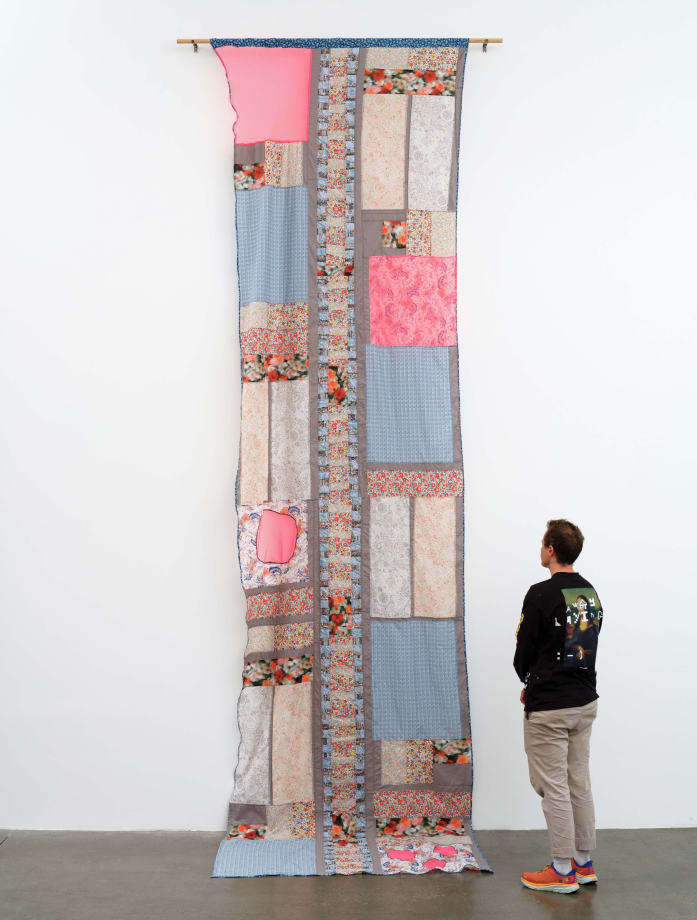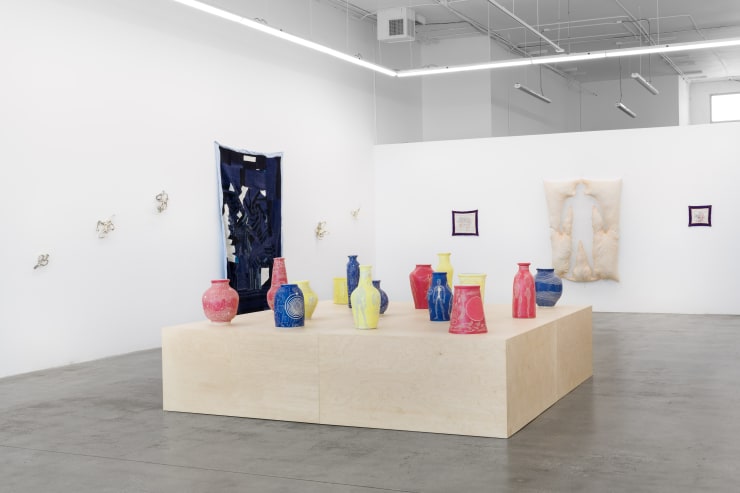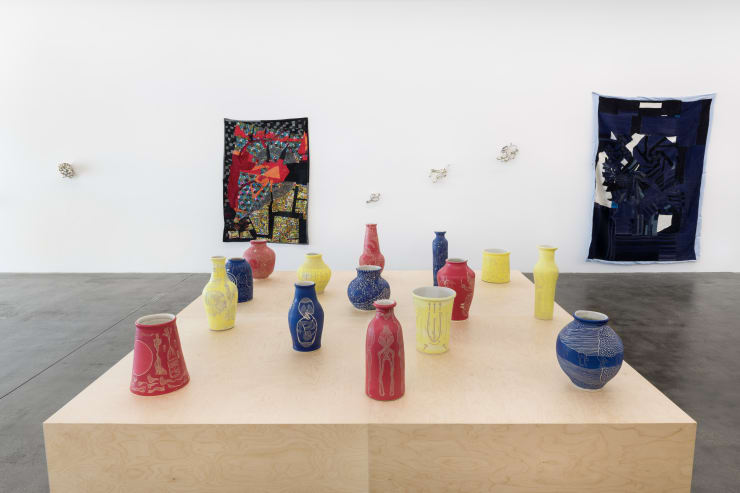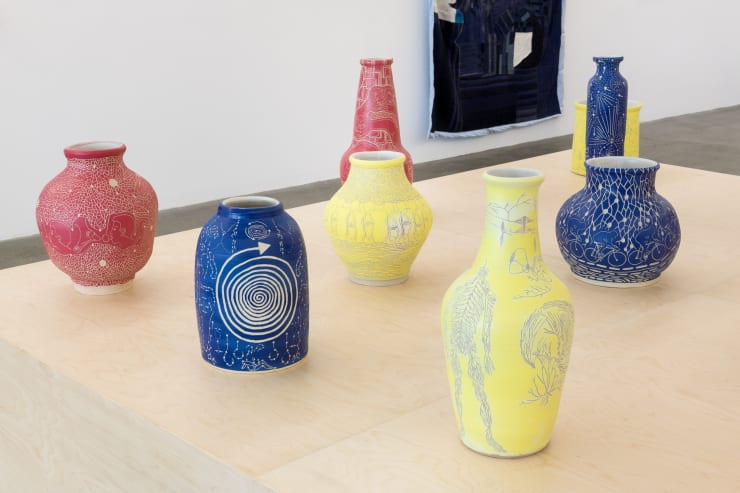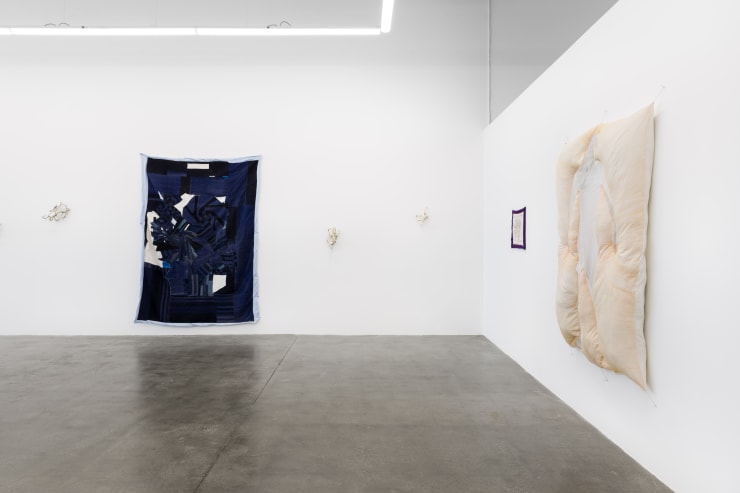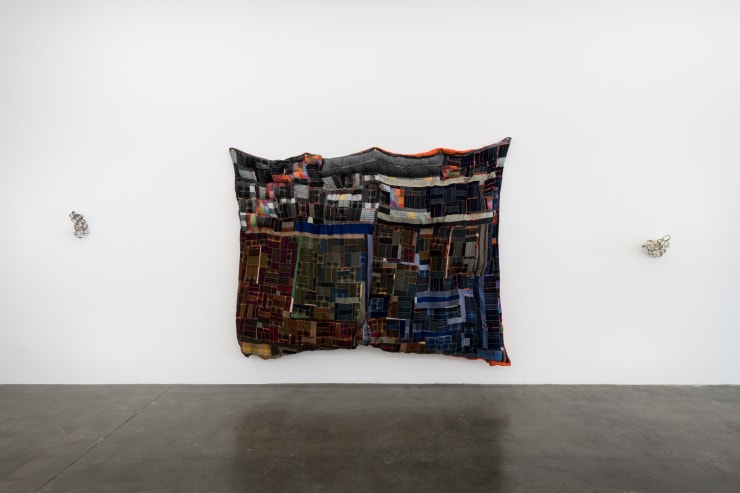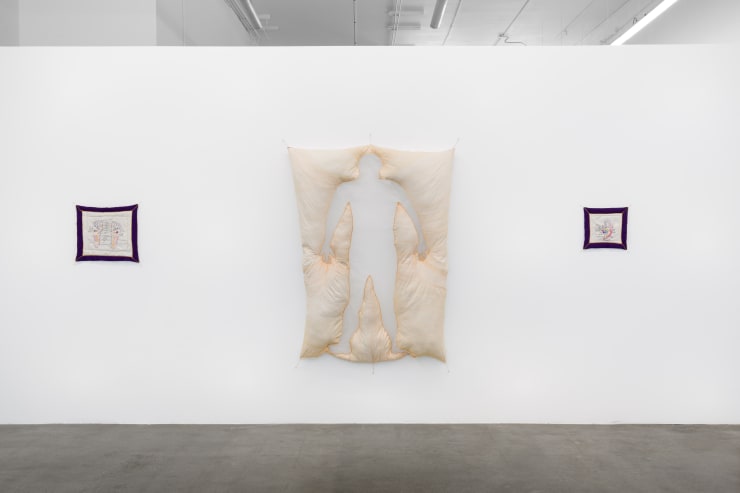Laub "Let me touch you": Hollywood
Past exhibition
Overview
Sebastian Gladstone is thrilled to present "Let me touch you", the gallery's first solo exhibition of the Los Angeles-based artist Laub. The exhibition will open on Saturday March 25th with an opening from 6-9PM and run through April 29, 2023.
'“Let me touch you,” perhaps more than other sentences, is a sequence of words that relies on the speaker to make its meaning in language. Hovering at the border of query and command, “Let me touch you,” portends potential seduction, exchange, or intrusion, and conveys desire and instruction. For Laub, care is at the center of the provocation “Let me touch you.” The works in the exhibition—ceramics, quilts and embroidered textiles, and glass sculpture—all carry the trace of the hand and the labor of the handmade. Made while studying anatomy to become a massage therapist, the works both contain and extend the curriculum of the body.
A series of wheel-thrown ceramic pots is based on systems of the body, and inspired by qigong exercises that circulate qi, or life force energy as understood in Chinese medicine, to move energy (blood, breath) through the body and all its systems. Flayed muscles, the electric currents of the nervous system, lymphatic fluid, the sex organs, and skeletal structure are drawn on underglazed pots and carved into the surface of the clay. Made in soft primary colors of red, yellow, and blue, each body system is depicted as a representation image, an abstracted concept, and a diagrammatic figure to be intervened as if by a care worker.
Textiles depicting reflexology are hand stitched with embroidery floss, turning the usual printed diagram seen in the waiting rooms and patient offices of healing practitioners into a dimensional and uneven surface, one that more nearly resembles the body in question. The charting of a bodily map, indicating how points of the hands and feet can both reference and summon body systems, organs, and glands, is one of many patterns and lines that relate the works in the exhibition. A series of sculpted hot glass evokes yet another element Laub thinks of as spirit. Hung on the wall as if clusters of broken bones or a beehive, the mirrored glass refracts light, and the glossy silver sheen gives the appearance of a robotic technology or prosthetic. Human and machine, skin and engine, blur in these works that could be assistance devices for bodies under construction. Hand stitched quilts made with Liberty of London prints, Harris Tweed, and Japanese fabric hand dyed with indigo reference the elements: earth, fire, water, air, and the body. A persistent thought for the artist in making the quilts is the volatile relationship between the elements and apocalypse. A preoccupation with smoke, fire, hurricanes and flood saturates the fabric, with tightly stitched patterns charging and dispersing the anxiety attendant to climate catastrophe.
In Laub’s study of the body and its mechanics, a narrative emerges of touch and transparency. What, these works ask, is the connective tissue between myself and my environment. The queer philosopher Karen Barad, who thinks with physics and its patterns and material configurations, describes “the mutual constitution of entangled agencies” as a process of intra-action. She borrows the concept of diffraction (a wave in an encounter with an obstacle, for example, how light bends) to propose that “reflection is about mirroring and sameness, diffraction attends to patterns of difference.” The body Laub depicts and imagines is one which takes gender to be part of the material and conceptual construction of the work. The feminine gendering of craft and the techniques associated with the hand and handmade is consciously played with, queered, and trans-ed (to use trans historian Susan Stryker’s notion of trans as doing) by Laub, who assembles an embodied pattern of tactile transgender materiality. In laying bare the physiology of anatomy, Laub considers how the body extracts and expresses its desires for transformation and connection. “Let me touch you” is a hope for a communal belonging.'
-Jeanne Vaccaro
'“Let me touch you,” perhaps more than other sentences, is a sequence of words that relies on the speaker to make its meaning in language. Hovering at the border of query and command, “Let me touch you,” portends potential seduction, exchange, or intrusion, and conveys desire and instruction. For Laub, care is at the center of the provocation “Let me touch you.” The works in the exhibition—ceramics, quilts and embroidered textiles, and glass sculpture—all carry the trace of the hand and the labor of the handmade. Made while studying anatomy to become a massage therapist, the works both contain and extend the curriculum of the body.
A series of wheel-thrown ceramic pots is based on systems of the body, and inspired by qigong exercises that circulate qi, or life force energy as understood in Chinese medicine, to move energy (blood, breath) through the body and all its systems. Flayed muscles, the electric currents of the nervous system, lymphatic fluid, the sex organs, and skeletal structure are drawn on underglazed pots and carved into the surface of the clay. Made in soft primary colors of red, yellow, and blue, each body system is depicted as a representation image, an abstracted concept, and a diagrammatic figure to be intervened as if by a care worker.
Textiles depicting reflexology are hand stitched with embroidery floss, turning the usual printed diagram seen in the waiting rooms and patient offices of healing practitioners into a dimensional and uneven surface, one that more nearly resembles the body in question. The charting of a bodily map, indicating how points of the hands and feet can both reference and summon body systems, organs, and glands, is one of many patterns and lines that relate the works in the exhibition. A series of sculpted hot glass evokes yet another element Laub thinks of as spirit. Hung on the wall as if clusters of broken bones or a beehive, the mirrored glass refracts light, and the glossy silver sheen gives the appearance of a robotic technology or prosthetic. Human and machine, skin and engine, blur in these works that could be assistance devices for bodies under construction. Hand stitched quilts made with Liberty of London prints, Harris Tweed, and Japanese fabric hand dyed with indigo reference the elements: earth, fire, water, air, and the body. A persistent thought for the artist in making the quilts is the volatile relationship between the elements and apocalypse. A preoccupation with smoke, fire, hurricanes and flood saturates the fabric, with tightly stitched patterns charging and dispersing the anxiety attendant to climate catastrophe.
In Laub’s study of the body and its mechanics, a narrative emerges of touch and transparency. What, these works ask, is the connective tissue between myself and my environment. The queer philosopher Karen Barad, who thinks with physics and its patterns and material configurations, describes “the mutual constitution of entangled agencies” as a process of intra-action. She borrows the concept of diffraction (a wave in an encounter with an obstacle, for example, how light bends) to propose that “reflection is about mirroring and sameness, diffraction attends to patterns of difference.” The body Laub depicts and imagines is one which takes gender to be part of the material and conceptual construction of the work. The feminine gendering of craft and the techniques associated with the hand and handmade is consciously played with, queered, and trans-ed (to use trans historian Susan Stryker’s notion of trans as doing) by Laub, who assembles an embodied pattern of tactile transgender materiality. In laying bare the physiology of anatomy, Laub considers how the body extracts and expresses its desires for transformation and connection. “Let me touch you” is a hope for a communal belonging.'
-Jeanne Vaccaro
Works
-
 Laub, Air, 2022
Laub, Air, 2022 -
 Laub, Earth , 2022
Laub, Earth , 2022 -
 Laub, Fire, 2022
Laub, Fire, 2022 -
 Laub, Body I, 2022
Laub, Body I, 2022 -
 Laub, Water, 2022
Laub, Water, 2022 -
 Laub, Body II, 2022
Laub, Body II, 2022 -
 Laub, Body III, 2022
Laub, Body III, 2022 -
 Laub, Neural II, 2022
Laub, Neural II, 2022 -
 Laub, Neural I, 2022
Laub, Neural I, 2022 -
 Laub, Neural III, 2022
Laub, Neural III, 2022 -
 Laub, Circulatory I, 2022
Laub, Circulatory I, 2022 -
 Laub, Circulatory II, 2022
Laub, Circulatory II, 2022 -
 Laub, Circulatory III, 2022
Laub, Circulatory III, 2022 -
 Laub, Lymphatic I, 2022
Laub, Lymphatic I, 2022 -
 Laub, Lymphatic II, 2022
Laub, Lymphatic II, 2022 -
 Laub, Lymphatic III, 2022
Laub, Lymphatic III, 2022 -
 Laub, Muscular I, 2022
Laub, Muscular I, 2022 -
 Laub, Muscular II, 2022
Laub, Muscular II, 2022 -
 Laub, Muscular III, 2022
Laub, Muscular III, 2022 -
 Laub, Skeletal I, 2022
Laub, Skeletal I, 2022 -
 Laub, Skeletal II, 2022
Laub, Skeletal II, 2022 -
 Laub, Skeletal III, 2022
Laub, Skeletal III, 2022 -
 Laub, Untitled ( Spirit 1 ) , 2023
Laub, Untitled ( Spirit 1 ) , 2023 -
 Laub, Untitled (Spirit 2) , 2023
Laub, Untitled (Spirit 2) , 2023 -
 Laub, Untitled (Spirit 3), 2023
Laub, Untitled (Spirit 3), 2023 -
 Laub, Untitled (Spirit 4), 2023
Laub, Untitled (Spirit 4), 2023 -
 Laub, Untitled (Spirit 5), 2023
Laub, Untitled (Spirit 5), 2023 -
 Laub, Untitled (Spirit 6), 2023
Laub, Untitled (Spirit 6), 2023 -
 Laub, Untitled (Spirit 9), 2023
Laub, Untitled (Spirit 9), 2023 -
 Laub, Untitled (Spirit 8), 2023
Laub, Untitled (Spirit 8), 2023 -
 Laub, Untitled (Spirit 7), 2023
Laub, Untitled (Spirit 7), 2023
Installation Views
